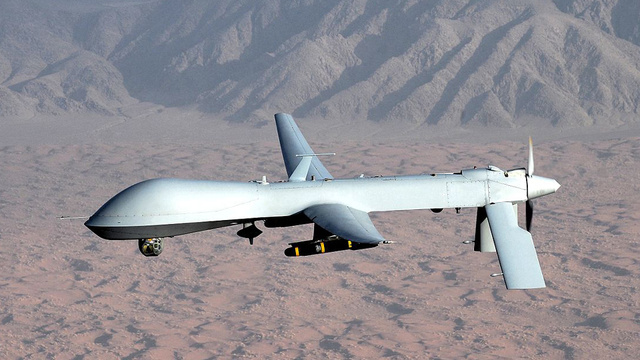
Last week, the Military Times ran a report based on statements from James Williams, the man from the Federal Aviation Administration that is “in charge of integrating unmanned aircraft into US airspace.” The story had an encouraging headline: “No Armed Drones in US Airspace.”
Over the next 10 years, unmanned aircraft could fill a number of commercial and government uses here at home – but those uses don’t include putting ordnance on target, said James Williams of the Federal Aviation Administration.
“We currently have rules in the books already that deal with releasing anything from an aircraft, period,” Williams said Wednesday. “Those rules are in place and are there that would prohibit weapons from being installed on a civil aircraft. We don’t have any plans on changing them for unmanned aircraft.”
An all out prohibition on armed drones over US airspace would indicate a significant check on the government’s growing powers expanding into uncharted territory thanks to the technological advances of unmanned aerial vehicles. Drones have made it easier for Washington to conduct covert warfare and surveillance in other countries, and those that are critical of their use have for years warned of their inevitable domestic application.
While Williams’s comment seems categorical – no armed drones over US airspace – his meaning is less clear. He mentions laws that prohibit weapons being installed on “civil aircraft.” What about the government? Certain US senators, including Sen. Rand Paul (R-KY) have made it a mission of theirs to get clarity on “whether or not the president can kill American citizens through the drone strike program on US soil,” given Obama’s declared authority to do so on foreign soil.
Steven Aftergood of Secrecy News gives further specificity to the question, citing a US Army manual. The army’s use of drones over US airspace is “constrained, not prohibited,” he reports.
There are significant barriers to the Army’s use of unmanned aerial systems within the United States, according to a new Army manual, but they are not prohibitive or categorical.
“Legal restrictions on the use of unmanned aircraft systems in domestic operations are numerous,” the manual states. The question arises particularly in the context of Defense Support of Civil Authorities (DSCA), refering to military assistance to government agencies in disaster response and other domestic emergencies.
“Use of DOD intelligence capabilities for DSCA missions–such as incident awareness and assessment, damage assessment, and search and rescue–requires prior Secretary of Defense approval, together with approval of both the mission and use of the exact DOD intelligence community capabilities. Certain missions require not only approval of the Secretary of Defense, but also coordination, certification, and possibly, prior approval by the Attorney General of the United States.”
As a general rule, “military forces cannot use military systems for surveillance and pursuit of individuals.” This is precluded by the Posse Comitatus Act, as reflected in DoD Directive 5525.5.
But there is a possibility that exceptions may arise, the manual indicates. “[Unmanned aircraft] operators cannot conduct surveillance on specifically identified U.S. persons, unless expressly approved by the Secretary of Defense, consistent with U.S. laws and regulations.” See U.S. Army Field Manual FM 3-52, Airspace Control, February 2013 (especially Appendix G).
So there are regulatory and procedural constraints on the government’s use of domestic drones in general, and the US Army manual prohibits the use of military systems for surveillance and “pursuit of individuals.” That would suggest pursuing individuals with drones – armed or unarmed – is not allowed. Furthermore, the Posse Comitatus Act restrains in principle the military’s domestic capabilities. So again, in principle, it would seem illegal.
But nothing here yet specifies what are the rules for the police force’s use of drones, to which Army manuals and Posse Comitatus do not apply.
Furthermore, many legal experts agree the President’s use of drones in targeted killings abroad is illegal. But that hasn’t prevented their expansive application. Indeed, to avoid legal scrutiny, the Executive Branch simply keeps the program technically secret and conducted by the CIA. Covert activities are those that would be illegal…if the government would make them public and submit to judicial review, which it refuses to do.
When it comes down to it, the question of whether armed drones will be used to pursue domestic targets depends on how robust the rule of law is – as opposed to rule by men. To what extent does the state submit itself to its own rules, laws, and promises? Not very much, especially in cases of “national security.”
Update: Josh Harkinson at Mother Jones reports that there are barely any specific rules restricting the state and local government’s use of drone technology. Harkinson illustrates the growing move for domestic police forces to get drones. Many of them, like Alameda County Sheriff Gregory Ahern, claim they want the drones for search and rescue purposes, and only to catch the worst federal criminals. But it isn’t hard to determine their true intent:
“I think this is the future of technology,” [Ahern] said, “and we can work together to make sure that this works appropriately.”
But barring written rules, privacy groups aren’t convinced that Ahern or other sheriffs can be trusted with drones. Last year, Ahern publicly pitched the drone to county lawmakers as a search-and-rescue tool, but told a different story in a grant application submitted to the Department of Homeland Security, which said the drone would assist with “surveillance (investigative and tactical)…intelligence gathering…suspicious persons, large crowd control disturbances, etc.” (Alameda County includes Oakland, where police battled with Occupy protesters last year.)


